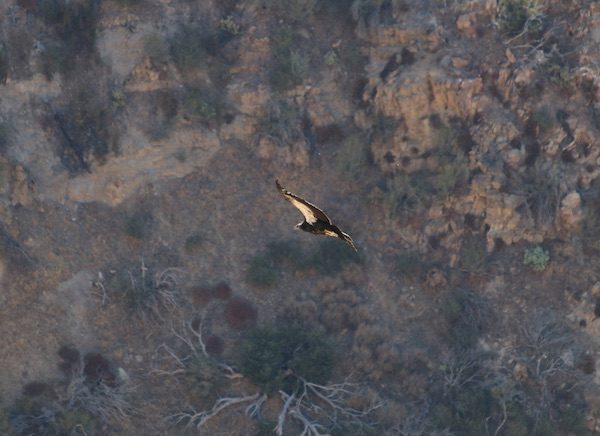Wild condor chick fledges from cliffs in Santa Barbara

The chick, known as condor 933, hatched in late April and was raised by a six-year-old female condor and a 38-year-old male condor, popularly known as AC-4. This new chick represents a milestone in the condor recovery program as the first second-generation wild fledgling in Southern California. The chick is also AC-4’s first offspring to successfully take flight from its nest in the wild.
For more than 30 years, AC-4 served a pivotal role in recovering California condors from near extinction. He was among 22 California condors – the last remaining on Earth – captured by biologists in the 1980s to create a captive breeding program. AC-4 was returned to the wild in 2015. While in captivity, he sired 30 chicks that were later released into the wild as part of the U.S. Fish and Wildlife Service-led California Condor Recovery Program.
“This is cause for celebration for everyone dedicated to saving California condors, but is particularly rewarding for us at the Santa Barbara Zoo, as the chick fledged in our ‘backyard,’” said Santa Barbara Zoo CEO Rich Block. “Since joining the recovery program in 2002, we’ve focused much of our field conservation efforts to condors, along with other local endangered and threatened species. Having condors successfully nesting in the Santa Barbara backcountry and flying over Santa Barbara skies is just great news.”
2018 was a record-breaking nesting season for California condors in southern California. Scientists recorded 12 nests in 2018 – the highest number of nests across the broadest range ever documented in the area.
“This record-breaking nesting season signals continued progress in the recovery of the California condor,” said Joseph Brandt, supervisory wildlife biologist with the Service’s Hopper Mountain National Wildlife Refuge Complex. “We are seeing more condors and more nests in more places in Southern California than ever before.”
Biologists from the U.S. Fish and Wildlife Service and Santa Barbara Zoo will continue to monitor the nest for the next month and expect to equip the chick with a tag and GPS transmitter within the next year.
In California, wild condors are found in the mountains of Monterey, San Benito, San Luis Obispo, Santa Barbara, Ventura, Los Angeles and Kern counties, and most recently in the western foothills of the Sierra Nevada Mountains in Tulare and Fresno counties. Within these counties much of the condor habitat is managed by the U.S. Forest Service. The Los Padres, Angeles, and Sequoia National Forests provide the growing condor population with wide open habitats that are important roost, nest, and foraging areas.
“The Los Padres National Forest supports California condor recovery efforts by actively managing core habitat areas such as the Sespe Condor Sanctuary and large tracts of important habitat, including the first condor release sites on the Ojai, Monterey, Santa Lucia, and Monterey Ranger Districts in the 1990s to today,” said Kevin Cooper, biologist with the Los Padres National Forest.
The number of California condors dropped dramatically in the mid-20th century, leading the Service to designate the species as endangered under the Endangered Species Act. By 1982 there were only 22 of the iconic birds left in the wild. Today, due to intensive, ongoing captive breeding and recovery efforts led by the Service in conjunction with multiple public and private partners, the California condor population has grown to around 470 birds worldwide, with more than half of the population flying free.
The number one killer of California condors is lead poisoning, caused by condors feeding on carcasses containing lead bullet fragments. When lead ammunition fractures inside the target animal, the fragments of the lead bullet can spread throughout the tissue of the animal that has been shot. As scavengers, condors unknowingly eat these small fragments and absorb the lead into their systems. Copper bullets, an effective lead alternative, are growing in popularity with the hunting community and minimize collateral wildlife damage as well as ingestion of lead fragments by hunters.
Another threat specific to condor chicks is “micro trash.” Micro trash are small coin-sized trash items such as, nuts, bolts, washers, copper wire, plastic, bottle caps, glass, and spent ammunition cartridges. Some condor parents collect these items and feed them to their chick which can cause serious problems with the chick’s development. While it is not completely understood why this occurs, many biologists believe that the condor parents mistake these items for pieces of bone and shell which provides a source of calcium if fed to the chick.
The U.S. Fish and Wildlife Service’s California Condor Recovery Program, is a multi-entity effort to recover the endangered California condor. Partners in condor recovery include the U.S. Forest Service, National Park Service, Bureau of Land Management, U.S. Geological Survey, Arizona Game and Fish Department, California Department of Fish and Wildlife, Utah Department of Fish and Wildlife, the federal government of Mexico, the Yurok Tribe, San Diego
For more information visit www.fs.usda.gov/lpnf.




















